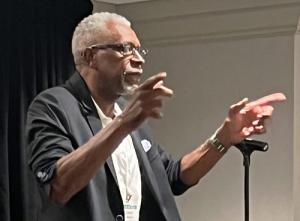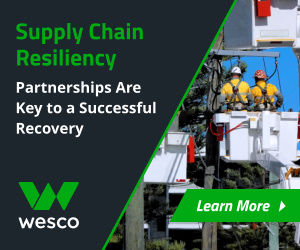ESG
Larry Glover has spent a career in executive marketing and communications roles at Proctor & Gamble Company, Coca-Cola Company, Sara Lee Corporation, and national advertising agencies. In recent years, he has focused on how utilities can best relate to and serve their low and moderate-income (LMI) communities. Glover’s undergraduate degree is from Hampton University. And his MBA work was done at the Marshall School of Business at the University of Southern California.
Diversity, equity, and inclusion has been the definer of corporate and social responsibility for at least the last fifteen years. Equity has been at the core of this important issue.

The idea of greater social responsibility among corporations and institutions has led to the rapid expansion of corporate diversity, equity, and inclusion programs and initiatives following the murder of George Floyd in 2020. DEI-related job postings increased by one hundred twenty-three percent between May and September of 2020 alone. Almost every governmental department has attempted to win public confidence and favor by including DEI and equity offices.
However, throughout the effort to achieve effective programing, the great challenge continues to be the ability to measure equity. Recognizing that equitable does not mean equal, how then do we measure equity and its impact on communities? The difficulty is in the variations of what constitutes real equity. When we arrive at a uniform agreement to its definition that is where our real work begins.
While we see strong corporate, social, and institutional support for equitable opportunities, equitable applications, and equitable impact and outcomes, we have yet to agree on what constitutes equity. How do we undertake the equity discussions, so we know when or if equity goals have been achieved?
How to Tackle the Problem
Research at the University of Portland sought to measure the impact of racial equity in energy. Work done by Dr. Destinie Knock of Carnegie Mellon sought to examine equity from an energy use and impact modeling study. The U.S. Census built a strong case that the 2019 CRE (Community Resilience Estimates) provides the base for defining equity as an understanding of the critical components necessary for community resiliency.
Equity is both reparative and preparative. Reparative, as noted by Nathaniel Smith of the Partnership for Southern Equity, who suggests that equity begins with reparative justice. That we must repair the history of damages already done to communities before considering new initiatives to be considered equitable.
Other community thought leaders assert that equity is removing systemic and intended structural barriers. So that each community can achieve its greatest possibility.
The real challenge of building equitable execution plans was not only defining the intended communities. But also defining what an equitable allocation of resources would look like.
The Census Bureau approach starts with the notion that community resiliency leads to our best possible solutions, where resilience is the capacity of individuals and households within a community to absorb the external stresses of a disaster.
We know that Black, brown, and under-resourced communities fare worse during any disaster. To measure this, the Census Bureau produced the 2019 Community Resilience Estimates, or CRE.
It has the ability to measure social vulnerability in a more equitable way. Because the CRE starts by analyzing information about individual people and households, it thereby starts the discussion at the eye of the storm. In the community itself.
Why it is Important to Measure Equity
So why measure equity for communities? The U.S. Government recently enacted the largest energy investment legislation in the history of the country, when considering together Justice40, the Inflation Reduction Act, and the Bipartisan Infrastructure Bill.
The desire is for an equitable distribution. Such that the Administration included a provision in Justice40 that forty percent of the federal investment spending should benefit disadvantaged and underserved communities.
That includes the greatest number of LMI communities ever targeted in the U.S. Except during the Lyndon Johnson 1964 Poor Peoples Campaign, which was the impetus for the development of local community action agencies to help impact poor communities. A clear attempt to achieve equity in the allocation, distribution, and impact of government resources.
Second, equity is measured so there is some accountability. Because if there is no accountability, how can progress be measured?
The Census Bureau tool includes a dashboard and data that helps us to understand communities' social vulnerability and equity. The CRE approach leans heavily on community resiliency. That is the capacity of individuals and households to absorb, endure, and recover from the health, social, and economic impacts of a disaster such as a hurricane or pandemic.
When disasters occur, recovery depends on a community's ability to withstand effects of the event. In order to facilitate disaster preparedness, the Census Bureau has developed new, small area estimates, identifying communities where resources and information may effectively mitigate the impact of disasters.
Community Equity
Variation in individual and household characteristics are determining factors in the differential impact of a disaster. Some groups are less likely to have the capacity and resources to overcome the obstacles presented during a hazardous event. Resilience estimates can aid stakeholders and public health officials in modeling these differential impacts and developing plans to reduce a disaster's potential effects.
Individual and household characteristics from the 2019 American Community Survey were modeled, in combination with data from the Population Estimates Program, to create the CRE. A close look at community risk factors that identify resiliency were distilled into a series of ten unique factors. All of which, when the data is analyzed, paints a clearer image of an affected community.
Risk factors from the 2019 American Community Survey include: income to poverty ratio, single or zero caregiver household, crowding, communication barriers, households without full-time year-round employment, disability, no health insurance, age sixty-five and over, no vehicle access.
Getting There from Here
The quest begins with a few well-placed questions. What innovative tools and techniques track equity? How is equity best measured? What approaches show where resources could be effectively deployed for the health of that community?
We must work with subject matter experts who have their own slice of the issue. For example, finding new ways to use mapping technology allows us to uncover insights from overlooked data that already exist. Such as using mapping technology that overlays redlined and discriminated communities' data, to help know where repetitive energy justice might start.
Data disaggregation helps study communities in a more detailed view. This can be seen in reviewing a 2021 energy affordability study commissioned by Washington D.C.'s Office of the People's Counsel. That study reviewed detailed data through the lens of demographics and energy equity dimensions by local community wards.
Data availability from sources not always used to evaluate community impact hold promise. That includes utility data to identify when and where energy resources are employed, and with what priority, with a keen eye on resiliency activity.
From the community perspective, recognize that the damage to under-invested communities has happened over a long period of time. It is unreasonable to think that the solution is short term.
The way back for communities to reach resiliency won't happen in a single meeting, a day, or a month. The pathway to a community's resiliency and recovery starts with equity in the community.



